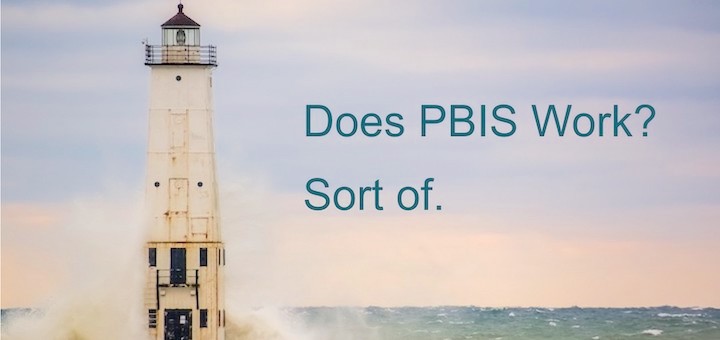You May Be Surprised About This PBIS Info
A MiddleWeb Blog
 PBIS (Positive Behavioral Interventions and Supports) rolled onto my scene in the early 2000’s, about when our fabulous art teacher at the time came up with a PBIS program called “Beads for Good Deeds.”
PBIS (Positive Behavioral Interventions and Supports) rolled onto my scene in the early 2000’s, about when our fabulous art teacher at the time came up with a PBIS program called “Beads for Good Deeds.”
Students and staff were given an empty necklace of rubber cord and a pack of cheerfully colored plastic beads, and asked to give the beads out to people in recognition of acts that supported school values: kindness, effort, achievement, etc. (We’ll get to that problematic “etc.” later).
It was not uncommon while I was teaching in this school to see folks wearing yards of beads they’d saved. It was eye-catching, fun, implemented with fanfare, had student buy-in, and fizzled out after five or six years.
Why? Primarily, my feeling was that the teacher who conceived of it got tired of being in charge of it, and we’ve absolutely all been there. But what was behind his fatigue is the better question, I think. To my mind the program failed because it didn’t bring about the lasting behavioral change among our kids we’d all hoped for.
Most of us educators are going to have stories like this. Failed and/or abandoned student reward systems and initiatives are legion, and one of their side effects is the way they can seal the adults who administer them over and over with a thick layer of cynicism, making it near impossible to find the energy to create future innovations that might work.
My new venture into PBIS
So here I am, 20-ish years later, and what have I volunteered for this year in my new district? You guessed it: a PBIS Tier I committee, gearing up for implementation now.
I was out of the classroom for a while during those 20-odd years and out of the PBIS game for a long time. I definitely needed to brush up on current PBIS events and practices. What was the up-to-the-minute research? What PBIS programs had actually worked during the last two decades?
I assumed that PBIS had been working, of course, or else why would it have stuck around so long in schools – more than 25,000 in 2018?
Never assume, folks.
IES’s take on PBIS
There is a LOT of information on PBIS and reward systems in schools (and rewards for people in general), but I am focusing on one meaty meta-study on elementary schools (96 of them) from diverse states and socioeconomic areas – published as recently as July 2022 by the Institute of Education Sciences, or IES, which is a gold standard for rigorous evaluation of education research.
Here’s what they stated about PBIS, which they note is also referred to as Multi-Tiered Systems of Support for Behavior (MTSS-B).
“There is little information educators can draw on about which strategies work and for whom; only a few MTSS-B programs have been rigorously evaluated, and none on a national scale.”
Dina: “Ugh.”
The MTSS-B program overall was no better than any other school-based behavioral strategy. Overall, it did not impact student behavioral outcomes or student achievement across the board.
Dina: “UGH.”
However, it DID have measurable benefits for those kids who were already identified as struggling behaviorally (our Tier II and III kids).
Dina: “OK, that’s better news…”
Solid implementation of the MTSS-B program led to improvements in some aspects of school climate, but not in perceived school discipline, which the report says “is noteworthy because it is key to the logic of how MTSS-B should work to benefit schools and students.”
Dina: “So PBIS is, in effect… every late-night commercial for tooth whitening?”
You can perhaps tell that I am struggling to break through my own layers of cynicism.
More importantly, though, I am on this Tier I committee and committed to making PBIS work. How can I bring this information back to my team in a way that is useful to us and to our kids?
Upping the usefulness of PBIS
First, several brains are always better than one. I’ll be circulating this study and asking our MTSS coordinator and other members to weigh in. Assuming that we can use these results as a general guideline for a middle school implementation of PBIS, what do we need to watch out for as we consider our own implementation? (Two other problems areas the report mentions are “fairness of policies” and “equal application of school rules.”)
Second, we can’t overlook the effects of the pandemic. Part of the funding we have for this program is based in the recognition that there is an elevated level of socio-emotional struggle amongst our kids. Does this mean that our “Tier II” has actually expanded significantly? Are more of our kids in a position to respond positively to PBIS than before the pandemic?
Third, we need to be very, very, VERY tight on defining desired outcomes, as this study makes clear. What outcomes is PBIS clearly demonstrated to affect? What outcomes are we looking for specifically in our district? Do these two sets of outcomes match up?
Meeting the challenges of rewards
In his book Why We Do What We Do, Ed Deci makes the point that what it means to be “a good person,” particularly in the case of kids, can be extremely nebulous, meaning anything that the observer wants it to mean.
For responsible rewards to work, there must be extreme clarity about what behaviors are expected. (In our long-ago Beads for Good Deeds program, everything from picking up a dropped book to getting an A on a test could be rewarded.) Generalized “good school behavior” – the “etc.” I mentioned above – will not cut it.
Finally, we should be considering the kind of rewards that do work. As it turns out, it’s pretty simple. For a reward to not negatively affect the level of intrinsic motivation of a person, the burden of Deci’s research indicates that it is the controlling intent of rewards which taints them. The less you use rewards to control, the less they negatively affect intrinsic motivation. As a simple means of acknowledgement, or of gratitude, they can be a different story.
As Deci writes succinctly, however: “Offering rewards in a non-controlling way requires a kind of deep honesty that often eludes people.” I hope the committee and I can find that honesty as we move forward.
Feature image by Jason Gillman from Pixabay




































Your frankness and wit made this refreshing to read, despite the news you share of discouragingly bleh research conclusions about PBIS’ effectiveness. The ‘Positive’ in PBIS was the radical good I picked up from working in an elementary school that really trained staff well. I wish you and your Tier I team well, and hope to hear how it goes.
Positivity is what I am hanging my hat on as well, Stephanie. It’s important to point out (and I should have done so more forcefully in the column) that MTSS and PBIS are not /exactly/ the same, though they are similar enough to warrant a close look at this research nonetheless. Thanks for your generous comment.
Dina, thanks for your candid and well-researched comments! I think it’s important that we not let any kind of PBIS become a bandaid solution for much deeper issues. You are right to question the results and look for solutions appropriate to your school,, your students, and your goals. It’s always important to start with a concrete answer to the question, “What is our goal here?” And, of course, you have to look at the question, “How will we know if and when we have achieved our goal?” I appreciate your willingness to approach your committee responsibility with research, with heart, and with humor!